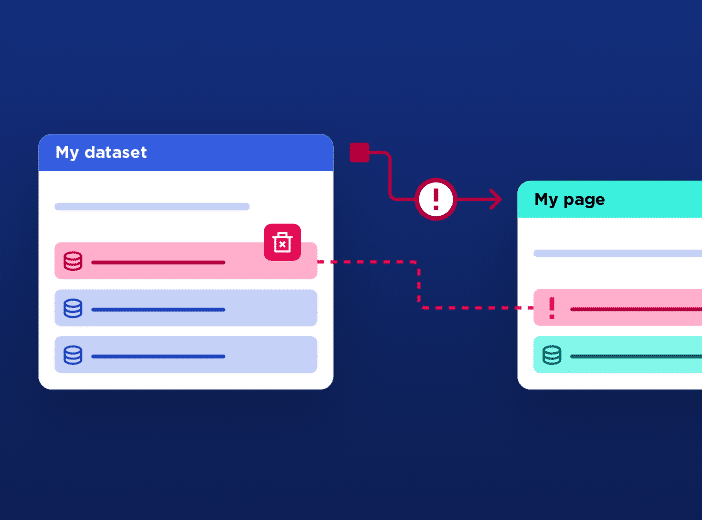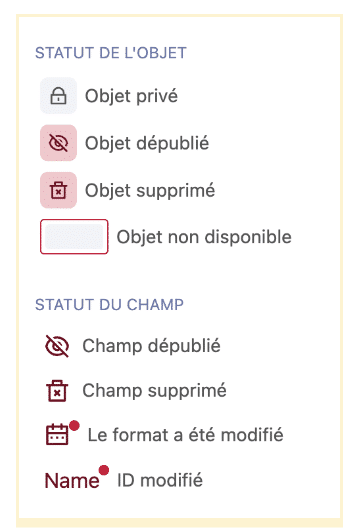Opendatasoft’s data lineage feature now enriched to enhance data usage analysis
Discover how updated data lineage provides a detailed understanding of the relationships and dependencies between objects in your portal, thanks to the new "field" level view.

In 2023, Opendatasoft launched its advanced data lineage functionality, focused on usage. Unique to the market and co-created with customers, it has seen rapid client adoption, thanks to its ability to demonstrate the value of your data portal and improve its maintenance.
In recent weeks, our product team has further enriched our lineage functionality to provide even greater precision and granularity in terms of usage analysis.
Discover how our updated data lineage functionality now provides a more detailed understanding of the relationships and dependencies between objects in your portal, thanks to the new field level view, as well as precise information on the nature of errors, including deletion and depublication.
The field-level view of data lineage
Until now, viewing data lineage relationships was limited to just one level between objects, for example from a dataset to a page. Opendatasoft’s data lineage feature now offers a much more granular view of dependencies between object fields (dataset, page, map, etc.). Map design has also been redesigned to include new information, such as the list of fields in use or the invalidity status of an object or field.
This provides an in-depth understanding of which fields within a dataset are used and which are not, and which are responsible for changes, dependencies or broken relationships between the various objects used.
This evolution provides new benefits for our customers, enabling them to:
- understand which fields are used within datasets, and which are the keys to a join
- have better visibility of data usage at a granular level
- better understand dependencies in order to avoid errors and solve problems
- obtain indications on how to correct invalid relationships.
In this way, portal administrators can ensure the quality of data shared via their data portal, improve compliance and governance, and optimize their data publication strategy in line with actual usage.
See which fields are reused and which are not
The field level view of data lineage allows organizations to observe which specific fields of a data asset are used and which are not. For example, if a municipality repurposes a map showing all the parking lots within its boundary, it is likely that the town name field will be unused since the map only uses data covering that specific area.
The data lineage feature’s legend has also been redesigned to enhance the readability of information. Additionally, users can now customize the map view by choosing whether to display object names or technical identifiers, and adjust grouping and field visibility to optimize display.
When no field in a source dataset is specifically used in a federation or source relationship, a message stating the following appears: “All fields are synchronized but not linked”.

Identify field-level reuse errors
The new field-level view is also enriched with information on relationship validity. This is a considerable help when optimizing data portal maintenance.
By quickly identifying errors and dependencies between objects, and then implementing targeted corrective measures, administrators can improve the quality of their data portals
For example, they can easily observe whether an object or field has been unpublished or deleted from the initial dataset, enabling them to understand the impact on the updating process for different reuses.
A tooltip – or hint – is displayed when the cursor hovers over an invalid relationship, providing information on the cause of the error.


Adding the original source of the dataset
To further enhance our data lineage functionality, it also provides added precision around the origin of the data assets used.
Our customers can now see which external source the data asset they are looking at comes from, for example, whether it is a dataset imported from Excel, a map imported from Waze, or asset data retrieved from a third-party tool.
The integration of the field-level view into Opendatasoft's data lineage represents a significant improvement both in our use of this functionality, and of the solution as a whole. This evolution not only enables us to spot and correct errors more easily, but also to better understand the structure and sequence of data. This is particularly useful with complex datasets or those developed by other stakeholders. Data lineage has become an indispensable tool in our daily working lives, saving us precious time and helping us to work with greater reassurance regarding our data. For example, before deleting a little-used or unused dataset, we always now use the lineage tool to minimize the risk of issues. The updated data lineage feature is extremely comprehensive, and meets all our expectations in this area.
Would you like to find out more about Opendatasoft’s data lineage? Request a demo with one of our experts!



